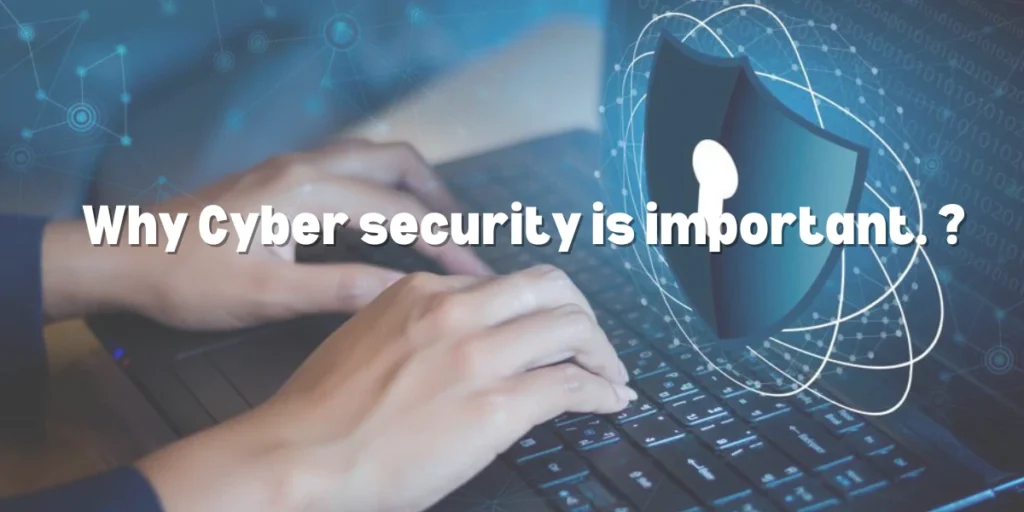
Introduction: Why Cyber security is Important ?
In our super-connected digital world, cyber security isn’t just nice to have; it’s a must. It’s all about keeping systems, networks, and data safe from cyber attacks. For individuals, businesses, and governments alike, the importance of cyber security is key in protecting sensitive info from bad actors. Cyber threats are always changing, and as we rely more on digital platforms, the risks of data breaches, losing money, and disruptions in operations are increasing too. The shift toward cloud computing, remote work, and the Internet of Things (IoT) makes defending against cyber threats even more complicated, so it’s vital for organizations to keep up with potential dangers.
Importance of Cyber security in a Digital Age
As companies move their work online more and more, they’re gathering and storing huge amounts of data, including personal, financial, and health info. With everyone using digital platforms for everything, from shopping to health services, cybercriminals are finding plenty of ways to exploit weaknesses. Data breaches can result in huge fines, harm to reputation, and legal troubles. For example, the General Data Protection Regulation (GDPR) and California Consumer Privacy Act (CCPA) have serious penalties for firms that don’t properly protect personal data.
Also, the rise of cloud computing, artificial intelligence (AI), and the IoT is expanding digital attack surfaces. Each connected device is a possible entry point for cybercriminals. Without proper cyber security steps, those devices could get hacked, leading to data theft or system takeovers. This has made cyber security a top concern for businesses and governments alike.
Essential Parts of a Strong Cyber security Strategy

A good cyber security strategy is layered and involves a bunch of tools and protocols working together for maximum safety. Here are the main parts of a good cyber security plan:
1. Application Security: Keeping software and apps secure is super important. Weaknesses in apps can be exploited by attackers to get unauthorized access. Regular security tests, checking for vulnerabilities, and managing patches are must-dos for keeping apps safe from threats.
2. Information Security: Data encryption is a key part of information security. Protecting sensitive data while it’s shared (in transit) and when it’s saved (at rest) stops unauthorized access. Using strong encryption methods, secure access management, and classifying data can help cut down the risk of data leaks.
3. Network Security: Keeping a network safe means protecting its parts—like servers, routers, and endpoints—from attacks. Firewalls, intrusion detection systems (IDS), and virtual private networks (VPNs) are crucial in keeping networks secure from unauthorized access.
4. Cloud Security: With more businesses using cloud computing, securing cloud-based apps and services has become essential. Multi-factor authentication (MFA), encryption, and the principle of least privilege are important steps to keep cloud environments secure.
5. Disaster Recovery and Business Continuity Planning: Even with the best measures, breaches can still happen. A disaster recovery plan helps businesses bounce back quickly from a breach and keep running. Planning for business continuity ensures that organizations can operate during and after a cyber security event.
6. Operational Security: Good operational security means managing who can access sensitive data and systems. Identity and Access Management (IAM) systems help make sure that only authorized people can reach critical information.
7. Critical Infrastructure Security: Protecting essential services like healthcare, finance, and energy is crucial. Cyberattacks on critical infrastructure can have serious effects on society.
8. End-User Education: Employees and users can often be the weakest link in the security chain. Educating them to spot threats, like phishing emails, and promoting the use of strong passwords can really lower the chances of successful attacks.
The Changing Cyber security Threat Landscape in 2024

The threat landscape in 2024 is way more complicated than just a few years back. While traditional attacks like malware and phishing are still around, new and smarter attacks are popping up. Advanced persistent threats (APTs), where cybercriminals sneak into a system and stay undetected for long periods, are becoming more common. These attacks are especially dangerous because they let attackers steal lots of data over time.
Plus, ransomware attacks have turned into one of the most financially damaging types of cybercrime. In these attacks, hackers lock users out of their data or systems and demand a payment for the decryption key. The rise of cryptocurrency makes it even harder to trace and punish these attacks.
Phishing remains one of the easiest and most common ways for attackers to deceive users into revealing sensitive info. These attacks can be very targeted, often pretending to be real emails from trusted sources, tricking users into clicking bad links or downloading harmful files.
Another growing worry is supply chain attacks, where hackers go after less secure parts of a company’s supply chain. These indirect attacks can be tricky to spot and prevent since they take advantage of trusted relationships between businesses and their suppliers.
Top Cyber security Threats in 2024
Let’s take a look at some of the major threats organizations are dealing with in cyber security:
1. Malware: Malicious software, like viruses, worms, and spyware, is an ongoing threat to systems everywhere. Malware is built to harm systems, steal data, or even give attackers control of a device.
2. Ransomware: This type of malware encrypts a user’s files and asks for payment to get them back. Sometimes, attackers might even threaten to publish sensitive info if the ransom isn’t paid.
3. Phishing: Phishing attacks are often fake emails that trick users into giving up sensitive data like passwords or credit card numbers. These attacks are getting smarter, with cybercriminals using personalized emails to fool victims.
4. Distributed Denial-of-Service (DDoS): DDoS attacks aim to crash a network or system by bombarding it with traffic, making it unusable. These attacks can be disruptive, costly, and tough to defend against.
5. Advanced Persistent Threats (APT): In APTs, attackers infiltrate systems and stay undetected for long times, gradually harvesting sensitive info. APTs are usually carried out by state-sponsored actors or organized crime outfits.
6. Insider Threats: Security breaches don’t always come from outside attackers. Sometimes, employees, contractors, or vendors inadvertently—or deliberately—cause breaches by mishandling sensitive info or misusing their access to internal systems.
7. Man-in-the-Middle (MitM) Attacks: In these attacks, cybercriminals intercept and manipulate communication between two parties to steal data or inject bad code.
Cyber security Challenges in 2024

As the threat landscape becomes more intricate, firms face a lot of challenges in keeping safe:
1. Evolving Threats: The fast pace of tech changes makes it tricky to keep up with new attack methods. Cybercriminals are always coming up with new ways to get around security measures, so businesses have to stay alert.
2. Data Overload: With businesses saving more data than ever, the chance of data breaches goes up. Managing this huge amount of info securely is one of the biggest challenges for modern firms.
3. Cyber security Skills Gap: There’s a worldwide shortage of cyber security professionals. This skills gap leaves many businesses vulnerable since they can’t find the talent needed to build and keep strong defenses.
4. Cyber security Training: Human mistakes are a major cause of security breaches. Regular training and awareness programs for employees are vital in reducing the chances of cyber incidents.
5. Supply Chain Vulnerabilities: Attacks on third-party vendors or service providers can affect entire networks. Making sure that partners and suppliers have solid security measures is essential for reducing this risk.
Best Practices for Effective Cyber security
To fight the growing threats, organizations need to adopt a solid set of cyber security best practices, such as:
- Regular Software Updates: Keeping all software updated with the latest security patches helps close vulnerabilities that attackers might exploit.
- Strong Passwords and MFA: Using unique, strong passwords for every account and turning on multi-factor authentication adds extra layers of security against unauthorized access.
- Employee Training: Ongoing training programs can teach employees how to spot phishing attempts, use secure passwords, and follow other security best practices.
- Backup and Recovery: Regularly backing up critical data and testing recovery processes lets a business quickly restore operations after a cyber event.
- Encryption: Encrypting sensitive data, both at rest and while it moves, helps keep info safe from unauthorized access.
- Incident Response Plans: Having an incident response plan ready prepares an organization to react quickly and effectively if there’s a breach.
The Role of Automation in Cyber security
As cyber threats grow more complex, more organizations are turning to automation in cyber security. Automation, driven by AI and machine learning, helps organizations monitor, detect, and deal with threats in real-time.
1. Threat Detection: AI systems can look through huge amounts of data to spot weird activities and predict possible threats before they even happen.
2. Automated Response: When a threat is found, automated systems can jump into action, like isolating infected devices or blocking shady traffic, without waiting for human help.
3. Efficiency and Scalability: Automation lets cyber security teams focus on bigger tasks by taking care of routine things like log checking, threat detection, and patch management.
Conclusion: Building a Safe Future
In 2024 and beyond, cyber security will keep being a crucial part of the digital landscape. As threats change and grow more complex, both businesses and individuals have to take proactive steps to safeguard their systems and data. By following best practices, investing in cutting-edge tech like AI-driven automation, and fostering a culture of cyber security awareness, organizations can remain strong against increasing cyber threats.
The key to cyber security is prep, staying alert, and always adapting. With the right strategies in place, it’s possible to create a secure digital future where data, systems, and operations stay safe from even the slickest cyberattacks.


